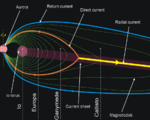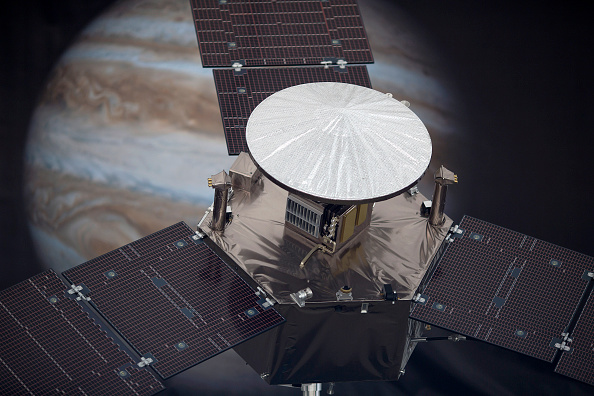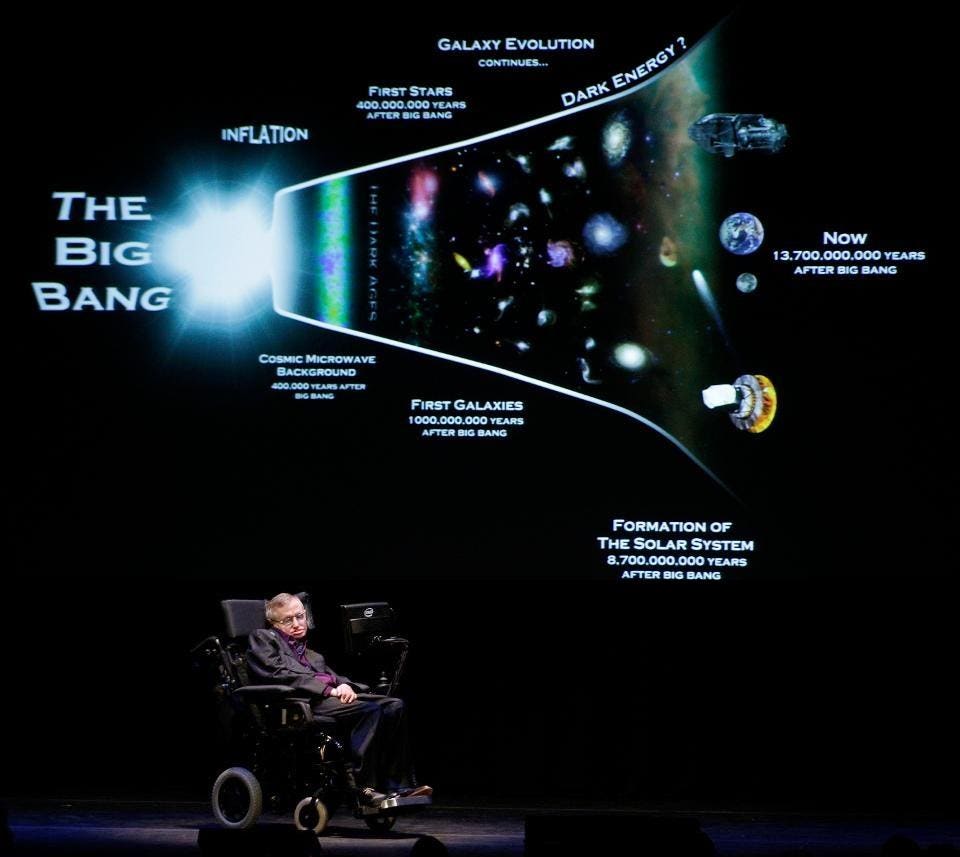The Daily Galaxy, Maxwell Moe, astrophysicist, NASA Einstein Fellow, University of Arizona via University College London - Jul 13, 2021 in Astronomy, Science, Solar System

Hubble telescope picture shows the aurora of glowing gas wrapped around Jupiter’s north pole . This curtain of light is produced when high-energy electrons race along the planet’s magnetic field and into the upper atmosphere where they excite atmospheric gases, causing them to glow. This Hubble image, taken in ultraviolet light, also shows the glowing “footprints” of three of Jupiter’s largest moons: Io, Ganymede, and Europa. NASA/ESA, John Clarke (University of Michigan)
“We have seen Jupiter producing X-ray aurora for four decades, but we didn’t know how this happened. We only knew they were produced when ions crashed into the planet’s atmosphere,” says William Dunn at the University College London (UCL) Mullard Space Science Laboratory about the eerie, electric-blue curtains of light glowing one half billion miles away on the gas giant.
The X-rays are part of Jupiter’s aurora—bursts of light that occur when charged particles interact with the planet’s atmosphere and magnetic field. Jupiter’s magnetic field is extremely strong—about 20,000 times as strong as Earth’s—and therefore its magnetosphere, the area controlled by this magnetic field, is extremely large. If the aurora was visible in the night sky, it would cover a region several times the size of our moon.
The image aboveshows the main oval of the aurora, which is centered on the magnetic north pole, plus more diffuse emissions inside the polar cap.
A similar phenomenon occurs on Earth, explains researchers at University College London (UCL), creating the northern lights, but Jupiter’s is much more powerful, releasing hundreds of gigawatts of power, enough to briefly power all of human civilization.
In a new study, published in Science Advances, UCL researchers combined close-up observations of Jupiter’s environment by NASA’s satellite Juno, which is currently orbiting the planet, with simultaneous X-ray measurements from the European Space Agency’s XMM-Newton observatory (which is in Earth’s own orbit).

These overlaid images of Jupiter’s poles were taken from NASA’s satellite Juno and NASA’s Chandra X-ray telescope. Left shows a projection of Jupiter’s Northern X-ray aurora (purple) overlaid on a visible Junocam image of the North Pole. Right shows the Southern counterpart. Credit: NASA Chandra/Juno Wolk/Dunn
The research team, led by UCL and the Chinese Academy of Sciences, discovered that X-ray flares were triggered by periodic vibrations of Jupiter’s magnetic field lines. These vibrations create waves of plasma (ionized gas) that send heavy ion particles “surfing” along magnetic field lines until they smash into the planet’s atmosphere, releasing energy in the form of X-rays.
View: https://www.youtube.com/watch?v=dplSgv6qlMk
“Now we know these ions are transported by plasma waves—an explanation that has not been proposed before, even though a similar process produces Earth’s own aurora. It could, therefore, be a universal phenomenon, present across many different environments in space.”
For the first time, astronomers have seen the way Jupiter’s magnetic field is compressed, which heats the particles and directs them along the magnetic field lines down into the atmosphere of Jupiter, sparking the X-ray aurora. The connection was made by combining in-situ data from NASA’s Juno mission with X-ray observations from ESA’s XMM-Newton. Credit: ESA/NASA/Yao/Dunn
X-ray auroras occur at Jupiter’s north and south poles, often with clockwork regularity. During this observation, Jupiter was producing bursts of X-rays every 27 minutes.
The charged ion particles that hit the atmosphere originate from volcanic gas pouring into space from giant volcanoes on Jupiter’s moon, Io. The gas becomes ionized (its atoms are stripped free of electrons) due to collisions in Jupiter’s immediate environment, forming a donut of plasma that encircles the planet.
“Now we have identified this fundamental process, there is a wealth of possibilities for where it could be studied next,” says co-lead author Dr. Zhonghua Yao (Chinese Academy of Sciences, Beijing). “Similar processes likely occur around Saturn, Uranus, Neptune and probably exoplanets as well, with different kinds of charged particles ‘surfing’ the waves.”
“X-rays are typically produced by extremely powerful and violent phenomena such as black holes and neutron stars, so it seems strange that mere planets produce them too. We can never visit black holes, as they are beyond space travel, but Jupiter is on our doorstep,”observes co-author professor Graziella Branduardi-Raymont (UCL Mullard Space Science Laboratory). “With the arrival of the satellite Juno into Jupiter’s orbit, astronomers now have a fantastic opportunity to study an environment that produces X-rays up close.”
For the new study, researchers analyzed observations of Jupiter and its surrounding environment carried out continuously over a 26-hour period by the Juno and XMM-Newton satellites.
They found a clear correlation between waves in the plasma detected by Juno and X-ray auroral flares at Jupiter’s north pole recorded by XMM Newton. They then used computer modeling to confirm that the waves would drive the heavy particles towards Jupiter’s atmosphere.
Why the magnetic field lines vibrate periodically is unclear, but the vibration may result from interactions with the solar wind or from high-speed plasma flows within Jupiter’s magnetosphere.
See: https://dailygalaxy.com/2021/07/mys...ers-x-ray-auroras-solved-ends-a-40-year-quest
It is very cool to find that the clockwork regularity of the 27 hour appearance of Jupiter's X-ray auroras coincide with the phased pumped charged ion particles originating from the volcanic gas on Io which strike Jupiter's atmosphere. The gas becomes ionized due to collisions in Jupiter's immediate environment, forming a plasma donut that encircles the giant planet.

The radio image of Jupiter on this page were recorded by the Australia Telescope National Facility (ATNF) of the Commonwealth Scientific and Industrial Research Organisation (CISRO). The Australia Telescope is a set of eight radio-receiving dish antennas at three sites in New South Wales. It is the largest single astronomical institution in Australia.
As Io's orbital motion carries it through this magnetized ring of ionized gas, a huge electrical current flows between Io and Jupiter. Carrying about two trillion watts of power, it's the biggest DC electrical circuit in the Solar System. You may tune into Jupiter at 20 Mhz. From the shortwave receiver, the so-called "L-burst" sounds like ocean waves crashing on a distant beach, while the S-burst sound like eerie drifting whistlers.
Hartmann352

Hubble telescope picture shows the aurora of glowing gas wrapped around Jupiter’s north pole . This curtain of light is produced when high-energy electrons race along the planet’s magnetic field and into the upper atmosphere where they excite atmospheric gases, causing them to glow. This Hubble image, taken in ultraviolet light, also shows the glowing “footprints” of three of Jupiter’s largest moons: Io, Ganymede, and Europa. NASA/ESA, John Clarke (University of Michigan)
“We have seen Jupiter producing X-ray aurora for four decades, but we didn’t know how this happened. We only knew they were produced when ions crashed into the planet’s atmosphere,” says William Dunn at the University College London (UCL) Mullard Space Science Laboratory about the eerie, electric-blue curtains of light glowing one half billion miles away on the gas giant.
The X-rays are part of Jupiter’s aurora—bursts of light that occur when charged particles interact with the planet’s atmosphere and magnetic field. Jupiter’s magnetic field is extremely strong—about 20,000 times as strong as Earth’s—and therefore its magnetosphere, the area controlled by this magnetic field, is extremely large. If the aurora was visible in the night sky, it would cover a region several times the size of our moon.
The image aboveshows the main oval of the aurora, which is centered on the magnetic north pole, plus more diffuse emissions inside the polar cap.
A similar phenomenon occurs on Earth, explains researchers at University College London (UCL), creating the northern lights, but Jupiter’s is much more powerful, releasing hundreds of gigawatts of power, enough to briefly power all of human civilization.
In a new study, published in Science Advances, UCL researchers combined close-up observations of Jupiter’s environment by NASA’s satellite Juno, which is currently orbiting the planet, with simultaneous X-ray measurements from the European Space Agency’s XMM-Newton observatory (which is in Earth’s own orbit).

These overlaid images of Jupiter’s poles were taken from NASA’s satellite Juno and NASA’s Chandra X-ray telescope. Left shows a projection of Jupiter’s Northern X-ray aurora (purple) overlaid on a visible Junocam image of the North Pole. Right shows the Southern counterpart. Credit: NASA Chandra/Juno Wolk/Dunn
The research team, led by UCL and the Chinese Academy of Sciences, discovered that X-ray flares were triggered by periodic vibrations of Jupiter’s magnetic field lines. These vibrations create waves of plasma (ionized gas) that send heavy ion particles “surfing” along magnetic field lines until they smash into the planet’s atmosphere, releasing energy in the form of X-rays.
“Now we know these ions are transported by plasma waves—an explanation that has not been proposed before, even though a similar process produces Earth’s own aurora. It could, therefore, be a universal phenomenon, present across many different environments in space.”
For the first time, astronomers have seen the way Jupiter’s magnetic field is compressed, which heats the particles and directs them along the magnetic field lines down into the atmosphere of Jupiter, sparking the X-ray aurora. The connection was made by combining in-situ data from NASA’s Juno mission with X-ray observations from ESA’s XMM-Newton. Credit: ESA/NASA/Yao/Dunn
X-ray auroras occur at Jupiter’s north and south poles, often with clockwork regularity. During this observation, Jupiter was producing bursts of X-rays every 27 minutes.
The charged ion particles that hit the atmosphere originate from volcanic gas pouring into space from giant volcanoes on Jupiter’s moon, Io. The gas becomes ionized (its atoms are stripped free of electrons) due to collisions in Jupiter’s immediate environment, forming a donut of plasma that encircles the planet.
“Now we have identified this fundamental process, there is a wealth of possibilities for where it could be studied next,” says co-lead author Dr. Zhonghua Yao (Chinese Academy of Sciences, Beijing). “Similar processes likely occur around Saturn, Uranus, Neptune and probably exoplanets as well, with different kinds of charged particles ‘surfing’ the waves.”
“X-rays are typically produced by extremely powerful and violent phenomena such as black holes and neutron stars, so it seems strange that mere planets produce them too. We can never visit black holes, as they are beyond space travel, but Jupiter is on our doorstep,”observes co-author professor Graziella Branduardi-Raymont (UCL Mullard Space Science Laboratory). “With the arrival of the satellite Juno into Jupiter’s orbit, astronomers now have a fantastic opportunity to study an environment that produces X-rays up close.”
For the new study, researchers analyzed observations of Jupiter and its surrounding environment carried out continuously over a 26-hour period by the Juno and XMM-Newton satellites.
They found a clear correlation between waves in the plasma detected by Juno and X-ray auroral flares at Jupiter’s north pole recorded by XMM Newton. They then used computer modeling to confirm that the waves would drive the heavy particles towards Jupiter’s atmosphere.
Why the magnetic field lines vibrate periodically is unclear, but the vibration may result from interactions with the solar wind or from high-speed plasma flows within Jupiter’s magnetosphere.
See: https://dailygalaxy.com/2021/07/mys...ers-x-ray-auroras-solved-ends-a-40-year-quest
It is very cool to find that the clockwork regularity of the 27 hour appearance of Jupiter's X-ray auroras coincide with the phased pumped charged ion particles originating from the volcanic gas on Io which strike Jupiter's atmosphere. The gas becomes ionized due to collisions in Jupiter's immediate environment, forming a plasma donut that encircles the giant planet.

The radio image of Jupiter on this page were recorded by the Australia Telescope National Facility (ATNF) of the Commonwealth Scientific and Industrial Research Organisation (CISRO). The Australia Telescope is a set of eight radio-receiving dish antennas at three sites in New South Wales. It is the largest single astronomical institution in Australia.
As Io's orbital motion carries it through this magnetized ring of ionized gas, a huge electrical current flows between Io and Jupiter. Carrying about two trillion watts of power, it's the biggest DC electrical circuit in the Solar System. You may tune into Jupiter at 20 Mhz. From the shortwave receiver, the so-called "L-burst" sounds like ocean waves crashing on a distant beach, while the S-burst sound like eerie drifting whistlers.
Hartmann352






